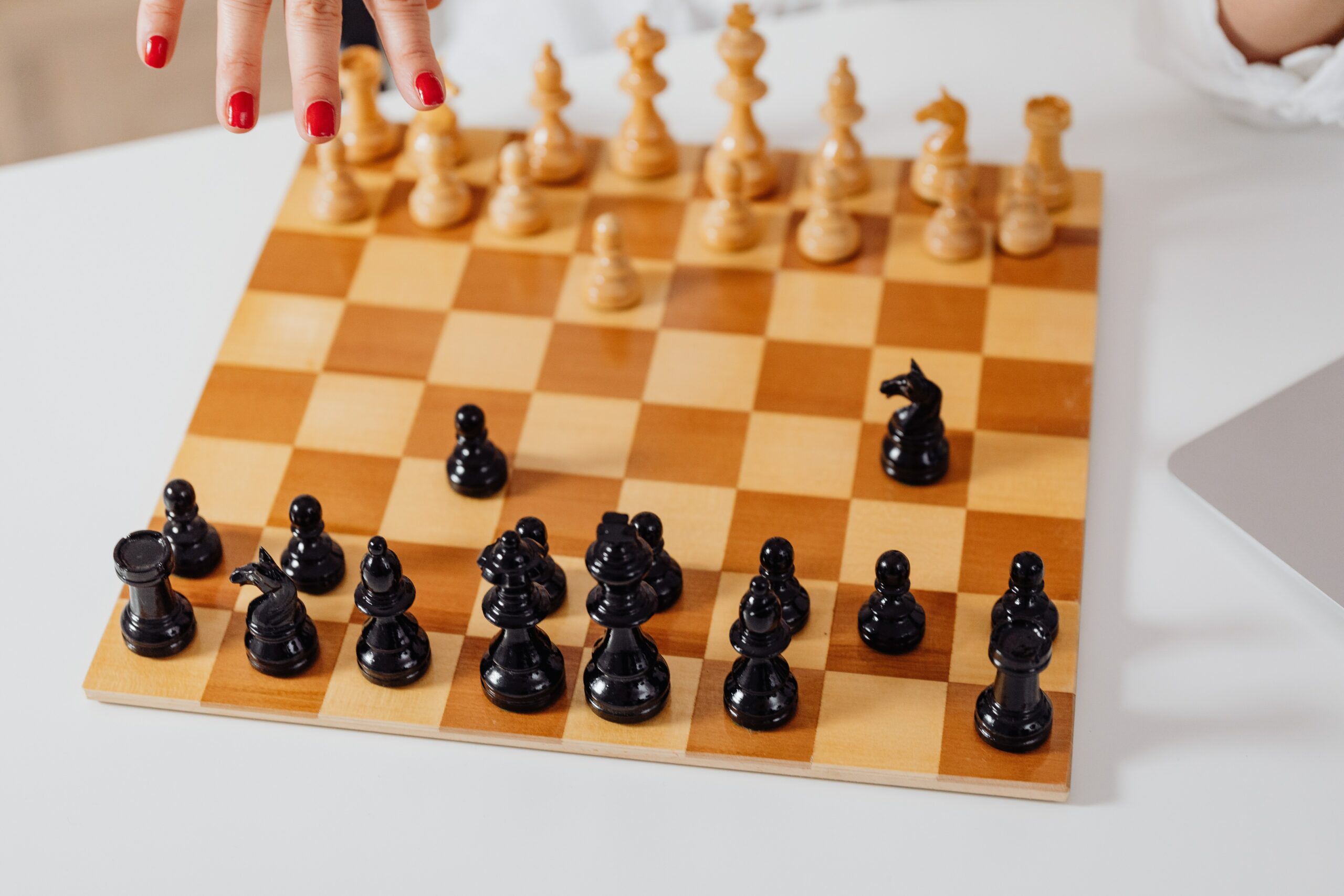Welcome to the world of chess, where strategy, intellect, and precision collide on the checkered battlefield. In this ancient game of kings and queens, the chessboard becomes a realm of limitless possibilities, where each piece holds its own unique power and purpose. To truly grasp the essence of this timeless game, it is essential to delve into the captivating realm of chess pieces and their moves.
At first glance, the chessboard appears like a blank canvas, awaiting the masterful strokes of players who seek to outwit their opponents. The chess pieces, each with their distinct character and capabilities, breathe life into this seemingly static expanse. From the steadfast pawns to the regal king and queen, every piece is an embodiment of strategy, positioning, and calculated maneuvers.
The names of the chess pieces themselves carry an air of mystery and fascination. The knight, with its enigmatic L-shaped jumps, gallops across the board, evoking visions of chivalry and daring escapades. The rook, resembling a tower, fortifies the ranks with its straight, unyielding path, commanding respect as the cornerstone of strategic planning. The bishop, the silent tactician, glides gracefully along the diagonals, wielding its influence across vast territories.
And then there is the queen, the most formidable and versatile piece on the board. With her ability to move in any direction, she embodies the epitome of power, symbolizing both grace and ruthlessness. Meanwhile, the king, the heart and soul of the game, must be protected at all costs, as the battle revolves around its survival.
So, step onto the chessboard, wield the power of the pieces, and immerse yourself in the captivating dance of intellect and strategy. Explore the myriad possibilities of each move, and discover the profound depths that lie within the enchanting names and movements of the chess pieces.
Why do Chess pieces have such unique names?
The unique names of Chess pieces can be traced back to the game’s historical origins and its evolution over time. Chess, as we know it today, has its roots in the ancient Indian game of Chaturanga.
As the game spread across different regions and cultures, the names of the pieces underwent various transformations. These names often reflect the historical and cultural context in which the game was played. For example, the English term “pawn” derives from the Old French word “paon,” meaning foot soldier or servant.
Similarly, the term “rook” is derived from the Persian word “rukh,” meaning chariot, highlighting its strategic role. The distinctive names add a layer of intrigue and charm to the game, capturing the imagination of players and contributing to the richness of its tradition.
What are the different types of Chess pieces?
In a standard game of Chess, there are six different types of pieces: the pawn, knight, bishop, rook, queen, and king. Each piece has its own set of unique characteristics and movements. The pawns are the smallest units and form the front line, advancing cautiously across the board.
Knights are known for their distinctive L-shaped jumps, allowing them to traverse the board in a non-linear fashion. Bishops move along the diagonals, traversing vast distances across the board. Rooks can move horizontally or vertically, dominating ranks and files.
The queen, often considered the most powerful piece, combines the movements of the rook and the bishop, capable of moving in any direction. Finally, the king, while limited in its movement, is of utmost importance as its capture results at the end of the game.

How does each Chess piece move on the board?
Each Chess piece has its own specific rules for movement. The pawn can move forward one square at a time, but on its initial move, it has the option to move two squares forward. Knights move in an L-shape, consisting of two squares in one direction and one square perpendicular to it.
Bishops can move any number of squares diagonally as long as the path is unobstructed. Rooks can move any number of squares horizontally or vertically. The queen has the combined movements of the rook and bishop, allowing it to move in any direction along ranks, files, or diagonals.
The king, on the other hand, can move one square in any direction but is restricted from moving into check (a position where it is threatened by an opponent’s piece). These distinct movements contribute to the strategic possibilities and tactical complexities of the game.
What is the significance of the King in Chess?
The king holds paramount importance in the game of Chess. Its ultimate objective is to be safeguarded at all costs. If a player’s king is under threat and cannot escape capture, it results in a checkmate, leading to the loss of the game.
Due to this significance, players must constantly consider the safety and positioning of their king. It often requires careful planning and maneuvering to protect the king, utilizing other pieces to create a defensive fortress.
The vulnerability of the king also contributes to the dynamic nature of Chess, as both players must balance offensive and defensive strategies while keeping their king secure.
How do the Queen’s movements make her the most powerful piece?
The queen is widely regarded as the most powerful piece on the Chessboard due to its exceptional range of movement. With the ability to move in any direction, whether horizontally, vertically, or diagonally, the queen can swiftly traverse vast distances and exert influence across the entire board.
This versatility enables the queen to engage in both offensive and defensive maneuvers, control crucial squares, launch attacks on multiple fronts, and dominate the opponent’s forces. The queen’s presence on the board often demands careful attention and strategic planning from both players, as its tactical potential can significantly shape the outcome of the game.
Can the Rook really control the entire board in the right position?
While it may be an exaggeration to claim that the rook can control the entire board single-handedly, in the right position, it can exert substantial influence over ranks and files. The rook’s ability to move horizontally and vertically allows it to traverse the board freely and target key areas.
By occupying open files or placing the rook behind advanced pawns, players can achieve dominance over certain sections of the board. The rook’s power is further enhanced when multiple rooks work together, coordinating their movements and applying pressure from different angles. However, controlling the entire board solely with rooks requires meticulous planning, precise execution, and favorable circumstances.

Why are the Bishop’s diagonal moves crucial for strategic gameplay?
The bishop’s diagonal movements are essential for strategic gameplay due to their unique scope of influence. Unlike other pieces, the bishop is limited to moving along diagonals. This characteristic enables the bishop to cover squares of only one color, making it complementary to the other bishop that moves on the opposite color squares.
The bishop’s capability to traverse long diagonals empowers it to control vast areas of the board, especially when unimpeded by pawns or other pieces. The ability to exploit both flanks simultaneously gives the bishop a strategic advantage, facilitating the execution of tactical maneuvers, attacking vulnerable enemy pieces, and supporting other units in coordinated assaults.
The diagonal moves of the bishop add depth to the game, demanding players to carefully consider their positioning and the potential for long-range attacks.
What is the Knight’s unique movement pattern and how can it be advantageous?
The Knight’s movement pattern is distinctive and often perplexing to novice players. It moves in an L-shape, consisting of two squares in one direction (horizontally or vertically) and one square perpendicular to it.
This allows the Knight to leap over other pieces and pawns, making it the only piece capable of bypassing obstacles on the board. The Knight’s unique movement confers it with several advantages. It can surprise opponents by accessing positions that other pieces cannot, enabling unexpected attacks or defense.
The Knight’s ability to jump over other pieces also makes it an excellent piece for initiating forks (simultaneously attacking multiple pieces), skewers, and other tactical maneuvers. Mastering the Knight’s intricate movement pattern is crucial for players seeking to exploit its strategic potential and surprise their adversaries.
How does the Pawn’s ability to promote add complexity to the game?
The Pawn’s ability to promote adds a layer of complexity and strategic significance to the game. Pawns begin their journey as the weakest pieces, restricted to single-step movements and capturing diagonally.
However, when a Pawn reaches the opposite end of the board, it can be promoted to any other piece (except the King) of the player’s choosing. This process transforms the Pawn into a powerful piece, potentially altering the dynamics of the game. The decision of which piece to promote the Pawn to depends on the player’s strategy and the specific needs of the position.
The promotion of a Pawn can lead to surprising comebacks, strategic breakthroughs, and dramatic turnarounds. It necessitates careful consideration of long-term plans, as the promotion of a Pawn can greatly impact the balance of power on the board.

Which piece is the most difficult to master and why?
The question of which piece is the most difficult to master is subjective, as each piece presents its own challenges and complexities. However, the Queen is often regarded as one of the most difficult pieces to wield effectively.
While the Queen possesses tremendous power and versatility, it can also become a target for opponents seeking to gain an advantage. The immense range of the Queen’s movement requires players to possess excellent positional judgment, foresight, and tactical acumen.
A poorly placed or overextended Queen can be vulnerable to attacks and result in losing tempo or material. Additionally, balancing offensive and defensive considerations while maximizing the Queen’s potential without exposing it to undue risks demands skill and experience.
Mastering the intricacies of the Queen’s powers and leveraging them optimally is a challenge that even seasoned players continue to face.
Can a Pawn capture a piece by moving diagonally?
Yes, a Pawn can capture an opponent’s piece by moving diagonally. Pawns have a unique capturing mechanism where they can take an enemy piece that is positioned one square diagonally forward from them.
This diagonal capture is a crucial aspect of pawn strategy and contributes to the tactical intricacies of the game. However, it’s important to note that Pawns cannot capture pieces directly in front of them. Their capturing ability is limited to the diagonal movement, adding further complexity to pawn dynamics on the chessboard.
| Chess Piece | Movement | Special Notes |
|---|---|---|
| King | One square in any direction | Can perform “castling” move with Rook |
| Queen | Any number of squares in any direction | Most powerful piece on the board |
| Rook | Horizontally or vertically any number of squares | Can control open files and ranks |
| Bishop | Diagonally any number of squares | Can control long diagonals |
| Knight | Moves in an L-shape: two squares in one direction and then one square perpendicular to the first direction | Can jump over other pieces |
How does the King’s special move called “castling” work?
“Castling” is a special move that involves the King and one of the Rooks. It allows the King to find a safer position and the Rook to become more active. Castling is executed by moving the King two squares towards the chosen Rook and then placing the Rook on the adjacent square next to the King.
This move is subject to specific conditions: neither the King nor the chosen Rook should have moved previously, the squares between them must be unoccupied, and the King cannot be in check or pass through a square that is under attack.
Castling offers several benefits, such as securing the King’s safety by placing it behind a protective wall of pawns and allowing the Rook to occupy a more central and active position. This move can be instrumental in safeguarding the King while simultaneously reinforcing the Rook’s potential influence on the board.
Final Thoughts
In conclusion, the names and moves of chess pieces add depth and intrigue to the game. Each piece has its own unique characteristics and movements, contributing to the strategic possibilities and tactical complexities of chess.
Understanding and mastering these names and moves are essential for players seeking to excel in the game and engage in thrilling battles on the checkered battlefield.




